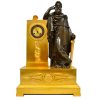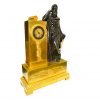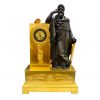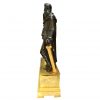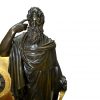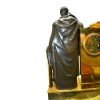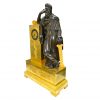French Empire Figural Bronze Clock Depicting an Allegory to Prudence or Wisdom
$12,000.00
A rare model of a French Empire mantle clock depicting an allegory to “La Prudenzia” or Prudence, Wisdom or Sound Judgement. This virtue is represented as a patinated bronze statue of of a classically draped bearded standing male figure leaning on a gilt bronze plinth legs crossed and with a sword in its scabbard by his side. There is an an open scroll on top of the plinth held in place by the figure’s elbow arm raised and forefinger of his hand pointing at his temple in a gesture associated with thinking. The plinth housing the clock dial and movement is decorated with a serpent coiled around a rod which along with the sword and scroll are associated with “La Prudenzia”.
The whole sits on a gilded rectangular base decorated with a finely cast frieze centred by a rondel showing the two Janus heads. In ancient Roman religion and myth, Janus is the god of beginnings, transitions, and endings. He is often depicted as having two faces, one looking to the future and one to the past.
The clock dial features a silvered chapter ring, the twin barrel movement with its original silk-string suspension movement rings the hours and halves on a bell.
An identical model of this clock is found in the Spanish Royal Collection. Refer to images.
Addendum: Its intended allegory to “La Prudenzia” apart, the imagery of this particular clock could easily be adapted to represent the apostle Saint Paul specifically in his role as the patron saint of the Mediterranean Island of Malta. The imposing intense looking tall bearded figure plus sword the scroll are all characteristics of how St Paul is often depicted in paintings. However, the symbol that could ostensibly represent the link to Malta is the snake coiled around a rod mounted on the face of the plinth housing the clock dial and movement,
The apostle Paul’s time in Malta is described in the Book of Acts (Acts 27:39–42; Acts 28:1–11). Saint Paul was shipwrecked in what is believed to be Malta in the year 60 AD, on his way to trial and eventual martyrdom in Rome. Legend has it that while gathering firewood for warmth, he was bitten by a venomous viper. The people there expected him to swell up and die rather quickly. When he was unaffected by the bite, the population assumed he was a god. While recovering from the effects of the shipwreck and waiting to continue his journey to Rome, St Paul proceeded to convert the Maltese who were at the time pagan under the Roman rule, to Christianity. The viper, the sword and scroll or often a book are the three symbols collectively associated with St Paul as the Patron Saint of Malta.
Dimensions: 25″H ( 64cm ) x 15.5″( 40cm ) W x 6.5″ ( 17cm ) D
Ref: OS NT7522
Out of stock


